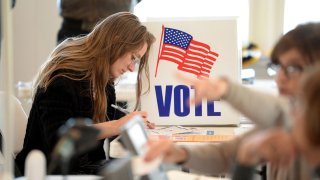
- Some older voters in key congressional districts switched allegiances from Republican to Democrat in the runup to the election, a recent AARP survey finds.
- The campaigns hold a lesson for Republicans to be more careful with their messaging around Social Security and Medicare.
- "Stop looking like you're going to jump on the third rail of American politics," one Republican pollster says.
An expected "red wave" of votes for Republican candidates did not come to fruition in the November midterm elections.
A post-election AARP survey points to one reason why — voters ages 50 and up, who represented 61% of the electorate in 63 of the most competitive congressional districts and helped give Democrats there a 2% edge.
The party's success was largely due to seniors, the survey found, particularly women 65 and up who switched support from Republicans to Democrats between July and November.
Get New England news, weather forecasts and entertainment stories to your inbox. Sign up for NECN newsletters.
The survey was conducted in November immediately after the election by bipartisan polling team Fabrizio Ward and Impact Research. It included 1,903 general-election voters and 450 nonvoters.
More from Personal Finance:
Why some worry about Social Security amid debt ceiling negotiations
Some want updates as Supplemental Security Income turns 50
Social Security benefits set to rise by over $140 per month
"Fifty-plus voters were the deciders," Tony Fabrizio, a Republican pollster and partner at Fabrizio Ward, said during a recent webinar hosted by AARP.
Money Report
Inflation and rising prices topped the list of overall voter concerns, with 33%, followed by abortion, 28%, and threats to democracy, 25%.
Democratic candidates ranked high with voters who are concerned most with abortion and threats to democracy. Republicans won with those worried about inflation, immigration and the economy.
"The fact that those three issues there — inflation, abortion and threats to democracy — were so close in terms of being the top driver of votes points to one of the reasons why this ended up being Democrats closely having the edge closely in these districts," Fabrizio said.
Senior voters, particularly women ages 65 and up, ranked threats to democracy and Social Security and Medicare among their top issues.
"Senior citizens certainly made the difference," Fabrizio said.
"The Democrats appeared to effectively target seniors with messages, particularly about Social Security and Medicare, that helped them regain footing with those voters," he said.
What Republicans and Democrats can learn
Based on the results, the bipartisan team of pollsters said there are key takeaways for both political parties going forward.
For Democrats, this was the second straight election where they had success with seniors, noted John Anzalone, a Democratic pollster and founder of Impact Research.
Their success this time around may be attributed to the wins they could share, he said, including new legislation to lower Medicare prescription drug prices.
"Republicans learned they need more of an agenda that touches people," Anzalone said.
"That's what I would say to members of Congress, 'Don't forget that people want to know what you've done, but also want to know your agenda and vision,'" he said.
Republicans could start by getting on board with prescription drug reform, Fabrizio said, which affects the broad population, not just seniors.
They should also be more careful with their messaging around Social Security and Medicare, he said.
"Stop looking like you're going to jump on the third rail of American politics, which is messing with Social Security and Medicare," Fabrizio said. "These people clearly want to see it protected and strengthened, and that's what we should be looking to do."






